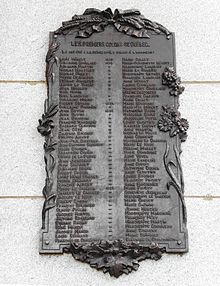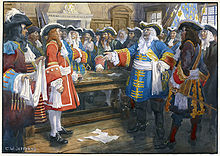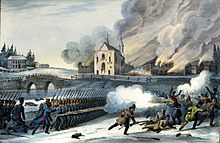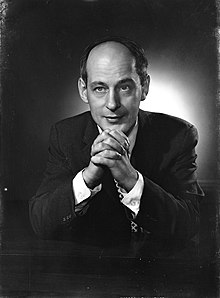History of Quebec
During this period, the inferior socio-economic status of francophones (because anglophones dominated the natural resources and industries of Quebec), the Catholic church, resistance against cultural assimilation, and isolation from non English-speaking populations were important themes.
Aboriginal peoples used a greater variety of local material, developed new techniques, such as polishing stone, and devised increasingly specialized tools, such as knives, awls, fish hooks, and nets.
For the Christian West, this made trade with the Far East, usually for things like spices and gold, more difficult because sea routes were now under the control of less cooperative Arab and Italian merchants.
[14] By 1700, fewer than 20,000 people of French origin were settled in New France, extending from Newfoundland to the Mississippi, with the pattern of settlement following the networks of the cod fishery and fur trade, although most Quebec settlers were farmers.
[17] In 1603, Samuel de Champlain travelled to the Saint Lawrence River and, on Pointe Saint-Mathieu, established a defence pact with the Innu, Wolastoqiyik and Micmacs, that would be "a decisive factor in the maintenance of a French colonial enterprise in America despite an enormous numerical disadvantage vis-à-vis the British colonization in the South".
[29] Because of war with England, the first two convoys of ships and settlers bound for the colony were waylaid near Gaspé by British privateers under the command of three French-Scottish Huguenot brothers, David, Louis and Thomas Kirke.
In 1713, following the Peace of Utrecht, the Duke of Orléans ceded Acadia and Plaisance Bay to the Kingdom of Great Britain, but retained Île Saint-Jean, and Île-Royale (Cape Breton Island) where the Fortress of Louisbourg was subsequently erected.
Stimulated by the influence in France of the popular religiosity of the Counter-Reformation, new orders for women began appearing in the seventeenth century and became a permanent feature of Quebec society.
[56] The rupture from France would provoke a transformation within the descendants of the Canadiens that would eventually result in the birth of a new nation whose development and culture would be founded upon, among other things, ancestral foundations anchored in Northeastern America.
After General John Burgoyne's failed 1777 campaign for control of the Hudson River, Quebec was used as a base for raiding operations into the northern parts of the United States until the end of the war.
In 1834, things hit a breaking point and the Parti canadien presented its 92 resolutions, a series of political demands which expressed a genuine loss of confidence in the British monarchy.
Louis-Joseph Papineau was instrumental in acting as a leadership figure for the rebels, yet his ideological views were ambiguous concerning the relative importance of seigneurial landowners, the Roman Catholic Church, and the francophone bourgeoisie.
In 1837, Louis-Joseph Papineau and Robert Nelson led residents of Lower Canada to form an armed resistance group called the Patriotes in order to seek an end to the unilateral control of the British governors.
[75] Following the government defeat of the Patriotes, the Catholic clergy recovered their moral authority among the people and preached for the cohesion and development of the nation in the fields of education, health and civil society.
[108] In the 1920s–1950s, this form of traditionalist Catholic nationalism became known as clerico-nationalism.The 1885 execution in Saskatchewan of Métis rebel leader Louis Riel resulted in protests in Quebec, as the French Canadians thought they were being deliberately persecuted for their religion and language.
[citation needed] Seizing the opportunity to build a coalition of his Liberals and dissident Conservatives, Mercier revived the "Parti National" name for the 1886 Quebec provincial election, and won a majority of seats.
After enormous difficulty in the federal government, because virtually every French-speaking MP opposed conscription while almost all the English-speaking MPs supported it, the Military Service Act became law on August 29, 1917.
[117] The worldwide Great Depression that began in 1929 hit Quebec hard, as exports, prices, profits and wages plunged and unemployment soared to 30%, and even higher in lumbering and mining districts.
Politically there was a move to the right, as Quebec's leaders noted that across the globe the failures attributed to capitalism and democracy had led to the spread of socialism, totalitarianism, and Civil War.
These strategies, Baillargeon finds, show that women's domestic labour—cooking, cleaning, budgeting, shopping, childcare—was essential to the economic maintenance of the family and offered room for economies.
Writing in the language of the street, Narrache adopted the persona of a man living in poverty who reflects on the ironies attending the meagerness of social assistance, the role of class, the pretensions of the commercial elite, and the counterfeit philanthropy of the rich.
Prime Minister William Lyon Mackenzie King tried, but did not succeed in, avoiding full conscription in Canada, and it became a reality in the final months of World War II.
The Quiet Revolution was particularly characterized by the 1962 Liberal Party's slogan "Maîtres chez nous" ("Masters in our own house"), which, to the Anglo-American conglomerates that dominated the economy and natural resources of Quebec, announced a collective will for freedom of the French-Canadian people.
The emergence of extremist nationalist violence marked a dark chapter in the province's history, when in 1963, the first bombs of the Front de libération du Québec were detonated in Montreal.
During an official visit to Quebec as a guest of the government of Canada, in front of a huge crowd the President of France, Colonel Charles de Gaulle, who had been temporarily given the rank of general in WWII, undiplomatically declared from the balcony of the Montreal city hall; "Vive le Québec libre!"
[153] Violence erupted in 1970 with the October Crisis, when Front de libération du Québec members kidnapped British Trade Commissioner James Cross and Quebec Minister of Labour Pierre Laporte.
On the night of November 4, 1981, (widely known among Quebec sovereigntists as La nuit des longs couteaux and in the rest of Canada as the "Kitchen Accord") Federal Justice Minister Jean Chrétien met with all of the provincial premiers except René Lévesque to sign the document that would eventually become the new Canadian constitution.
Parizeau resigned as Premier and as leader of the Parti québécois the day after his controversial speech, claiming he had always planned to do so in the case of separatist defeat, and Bouchard left federal politics to replace him in January 1996.
In January 2007, the town of Hérouxville received attention when it approved a code of conduct for immigrants, which occurred in the context of a debate on "reasonable accommodation" for other cultures in Quebec.
[163] During the 2011 Canadian federal elections, Quebec voters rejected the sovereignist Bloc Québécois in favour of the federalist and previously minor New Democratic Party (NDP).


















